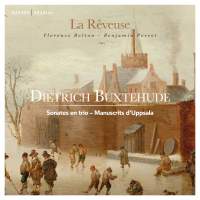Texte paru dans: / Appeared in: |
|
|
Outil de traduction ~ (Très approximatif) |
|
|
Reviewer: James
V. Maiello
Buxtehude’s Sonata in A Minor,
BuxWV 272, opens this recording of north German chamber music. Although the
somewhat slow tempo of the first movement robs it of some vitality, the
warmth of the violin is especially welcome. One might hope for more dramatic
treatment of line and dissonance in the second movement, but the distinctive
voices of the theorbo and violin create a welcome timbral contrast in the
final passacaglia. The soloists weave elegantly in and out of a tasteful
continuo texture. Dietrich Becker’s (1623–1679) Sonata and Suite in D Major
is a relative rarity on CD, and La Rêveuse gives its nine short movements a
thoroughly enjoyable reading. They keep things interesting even amid a
disproportionate number of slow movements through subtle changes in
articulation, phrasing, and other details. The brief Solo-Andante is one of
the work’s gems, the violin offering lyrical cantabile lines over a gentle,
theorbo-dominated continuo. All the dance movements are marked by careful
attention to the distinctive conventions of each genre, from the refined
courant to a dignified sarabande; a crisp gigue closes the work.
An anonymous solo for viola da
gamba and continuo is perhaps the most fascinating piece on the program,
beginning with a nebulous, three-minute “sonata.” Florence Bolton is a
deeply musical gambist, pulling sinuous lines and digging out satisfyingly
gritty double-stops. A substantial passacaglia-adagio follows, during which
the continuo offers a stimulating foundation, exploring a variety of
textures and instrumental combinations. Again, the soloist is excellent, and
one wonders who this anonymous north German composer was, exactly … surely a
gambist. Returning to Buxtehude, we find another chamber sonata, this time
in G Minor (BuxWV 261). Among the six movements, the centerpiece—another
passacaglia—is a standout, an opportunity for Stéphan Dudermel and Bolton to
shine together, playing off each other expertly; the closing gigue is also
one of the most vibrant selections on the recording. Buxtehude’s Sonata in D Major, BuxWV 267, features a different gambist, Emily Audouin, whose sound is sometimes reedier than Bolton’s and just as captivating; this is most apparent during the opening and closing movement. Audouin’s graceful style is really on display in the meaty fourth movement, which progresses through four distinct episodes. The program concludes with Buxtehude’s Sonata in B♭ Major, BuxWV 273. Both soloists are confident and just a touch joyful in the passagework of the opening movement, and the dances are idiomatic and restrained. As in other selections on the recording, the alternation of organ, harpsichord, and theorbo as the dominant voices in the continuo represent thoughtful choices and welcome contrasts.
This
recording is certainly worth hearing, especially for anyone interested in
the music that shaped the late Baroque style in Germany; the anonymous viola
da gamba solo and Becker’s sonata-suite provide some context to Buxtehude’s
music. These are polished performances all around, though they are often on
the safe side. Although some listeners might prefer more intensity, this is
more of a personal preference. The ensemble plays comfortably together and
it is a pleasure to listen to these works here. | |
|
|
|
|
|
|
|
Cliquez l'un ou l'autre
bouton pour découvrir bien d'autres critiques de CD |
|




